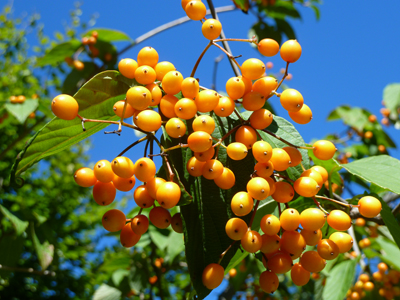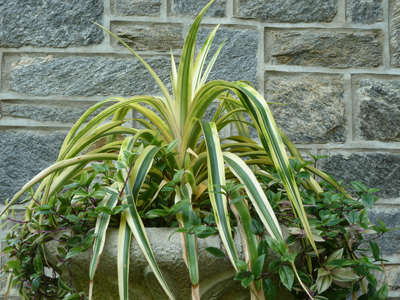Plants of the Week – September 17
 Fruiting viburnums are coming into their full glory. Viburnum nudum, the smooth witherod or possumhaw viburnum, is an east coast native growing 6-10’ tall and wide. Creamy white flower cymes appear in May and June. Fruits transition from green to pink to blueberry blue as the season progresses. Several cultivars have been released including ‘Winterthur’, BrandywineTM, and ‘Pink Beauty’. Photo credit: J. Coceano
Fruiting viburnums are coming into their full glory. Viburnum nudum, the smooth witherod or possumhaw viburnum, is an east coast native growing 6-10’ tall and wide. Creamy white flower cymes appear in May and June. Fruits transition from green to pink to blueberry blue as the season progresses. Several cultivars have been released including ‘Winterthur’, BrandywineTM, and ‘Pink Beauty’. Photo credit: J. Coceano
 Another stunning fruiting viburnum is Viburnum setigerum ‘Aurantiacum’. The cultivar produces bright orange fruit whereas the species bears red fruit. One criticism of V. setigerum is its leggy, lanky habit. Stems can reach 8-12’ in height with foliage primarily growing at the terminal growing ends. One solution is to plant this species in the back of the border allowing other plants to cover its “bare legs.” This simple trick hides a flaw while allowing the vibrant fruits to shine. Photo credit: J. Coceano
Another stunning fruiting viburnum is Viburnum setigerum ‘Aurantiacum’. The cultivar produces bright orange fruit whereas the species bears red fruit. One criticism of V. setigerum is its leggy, lanky habit. Stems can reach 8-12’ in height with foliage primarily growing at the terminal growing ends. One solution is to plant this species in the back of the border allowing other plants to cover its “bare legs.” This simple trick hides a flaw while allowing the vibrant fruits to shine. Photo credit: J. Coceano
Ananas comosus ‘Ivory Coast’ is a dramatic variegated pineapple. According to Eve Thyrum, Arboretum Assistant and author of 2012 Unusual Tropicals and Annuals Sale Catalog, A. comosus ‘Ivory Coast’ “is a terrestrial, rosette-forming perennial whose erect, sword-shaped, olive-green leaves have creamy white, spineless edges. When grown in full sun the foliage takes on rosy overtones. Mature specimens produce pyramidal clusters of small lavender flowers with showy pink bracts.” This pineapple cultivar is currently spending the growing season in a container next to Kohlberg Hall where it is partnered with Tradescantia fluminensis ‘Tricolor’. Photo credit: J. Coceano
 Florists and flower arrangers are familiar with alstromeria as it is a common component of cut flower arrangements. What people may not know is that several cultivars, including Alstroemeria ‘Tangerine Tango’ are winter-hardy perennials. Flowers first appear in May and continue through to frost. While the stems are capable of holding the inflorescence upright, it is beneficial to plant amongst companion plants. Here Begonia grandis provides support and contrast for Alstroemeria ‘Tangerine Tango’. Photo credit: J. Coceano
Florists and flower arrangers are familiar with alstromeria as it is a common component of cut flower arrangements. What people may not know is that several cultivars, including Alstroemeria ‘Tangerine Tango’ are winter-hardy perennials. Flowers first appear in May and continue through to frost. While the stems are capable of holding the inflorescence upright, it is beneficial to plant amongst companion plants. Here Begonia grandis provides support and contrast for Alstroemeria ‘Tangerine Tango’. Photo credit: J. Coceano






ann ainsworth
Posted at 19:06h, 20 SeptemberHi Josh, As usual, you do a great job with the pictures and the descriptions..ann a